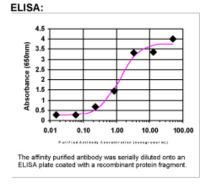cIAP2 (BIRC3) Rabbit Polyclonal Antibody
CNY 5,302.00
| Cited in 1 publication. |
CNY 300.00
CNY 1,430.00
CNY 2,900.00
CNY 6,650.00
CNY 3,080.00
CNY 9,998.00
CNY 3,080.00
Specifications
| Product Data | |
| Applications | ELISA |
| Recommend Dilution | ELISA: 1:100-1:2000 |
| Reactivity | Human |
| Host | Rabbit |
| Clonality | Polyclonal |
| Immunogen | DNA immunization. This antibody is specific for the N Terminus Region of the target protein. |
| Formulation | 20 mM Potassium Phosphate, 150 mM Sodium Chloride, pH 7.0 |
| Concentration | 1.09927 mg/ml |
| Purification | Purified from mouse ascites fluids or tissue culture supernatant by affinity chromatography (protein A/G) |
| Conjugation | Unconjugated |
| Storage Condition | Store at -20°C as received. |
| Gene Name | baculoviral IAP repeat containing 3 |
| Database Link | |
| Background | cIAP2 (API2, BIRC3, HIAP2, MIHC) is a member of the family of inhibitor of apoptosis proteins (IAP). IAPs suppress mitochondria-dependent and -independent apoptosis by binding to and inhibiting caspases through their BIR domains (reviewed in Liston et al, 2003; Wright and Duckett, 2005). Resistance towards apoptosis is a hallmark of cancer cells, and overexpression of IAPs can contribute to the development of cancer though inhibiting apoptosis. In addition to at least one BIR domain, some IAP members also have a RING-type finger motif at their carboxyl-terminal. The RING finger domain of several IAPs, including cIAP2, have E3 ubiquitin ligase activity and target the degradation of Smac/DIABLO through ubqiuitination. Smac/DIABLO is a death inducer and functions by inhibiting IAP-caspase interactions, thereby promoting apoptosis. Degradation of cell death inducers like Smac/DIABLO is thought to be a conserved mechanism by which IAPs enhance their anti-apoptotic activity, thereby promoting cell survival. The IAPs, including cIAP2, have widespread tissue protein expression, with expression levels and subcellular localization patterns differing depending on the cell lineage (see Vischioni et al. 2005 for a comprehensive study). cIAP2-MALT (API2-MALT1) fusion proteins have been implicated in the molecular pathology of mucosa associated lymphoid tissue (MALT) lymphoma (reviewed in Hosokawa, 2005). AP12-MALT fusion proteins are found in a subset of patients with MALT lymphoma. They are generated by chromosomal translocations whereby the N-terminal portion of AP12 (including the BIR domains) is linked to the C-terminal portion of MALT1 (containing at least an immunoglobulin-like domain and a caspase domain). Several variants of the API2-MALT1 fusion proteins can occur in MALT1 lymphoma patients depending on the chromosomal breakpoints. It is thought that AP12-MALT1 can enhance the activation of NK-kB signalling, which may be relevant to the pathology of MALT lymphomas. This antibody recognizes cIAP2, human cIAP2 is a 604 amino acid protein. This antibody should also recognize AP12-MALT1 fusion proteins assuming that they contain the cIAP2 peptide sequence (QDFSALMRSSYHCAMNNENAR) used for immunogen. The AP12-MALT1 fusion proteins is listed as an 1140 amino acid protein, GenBank no. AAD46161.1. However users should keep in mind that the actual amino acid length of AP12-MALT1 fusion proteins may vary depending on the chromosomal breakpoints. |
| Synonyms | AIP1; API2; c-IAP2; CIAP2; HAIP1; HIAP1; MALT2; MIHC; RNF49 |
| Note | This antibody was generated by SDIX's Genomic Antibody Technology ® (GAT). Learn about GAT |
| Reference Data | |
| Protein Families | Druggable Genome |
| Protein Pathways | Apoptosis, Focal adhesion, NOD-like receptor signaling pathway, Pathways in cancer, Small cell lung cancer, Ubiquitin mediated proteolysis |
Citations (1)
| The use of this Antibodies has been cited in the following citations: |
|---|
|
Evironmental pollutant perfluorodecanoic acid upregulates cIAP2 to suppress gastric cell senescence
,Zhang, Z;Song, N;Peng, Y;Fan, Z;Han, M;Zhao, M;Dong, T;Liu, S;,
Oncol. Rep.
,PubMed ID 30431128
[BIRC3]
|
Documents
| Product Manuals |
| FAQs |
| SDS |
Resources
| 抗体相关资料 |


 United States
United States
 Germany
Germany
 Japan
Japan
 United Kingdom
United Kingdom
 China
China

